Kitchen faucets: types, sizes and selection
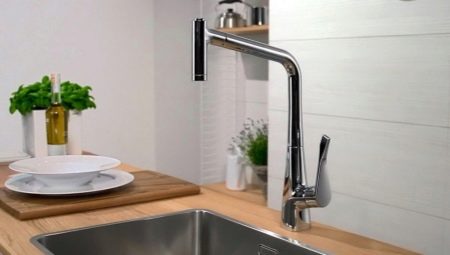
A kitchen mixer is almost the main element of plumbing in a room, which largely determines how convenient it will be to use a sink. Despite the fact that replacing it by itself may not be expensive and not take an excessive amount of time, any good owner would prefer to spend one time installing a convenient and reliable mechanism instead of thinking about replacement or repair every few years.
So that the chosen model does not disappoint you, you first need to understand the range and understand how a thoughtful choice is made.

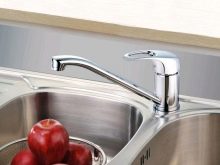
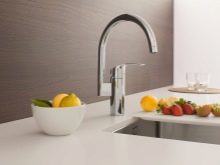
Views
Despite the seeming simplicity of such a device, modern kitchen faucets can have radically different principles of operation and it cannot be said that at least one of the varieties is fundamentally better than the others. Your choice depends on how you understand your own convenience, how much money you are willing to spend in order to achieve it. To help you navigate the variety of assortment, consider the most common types of water faucets.
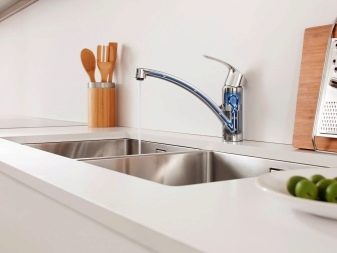
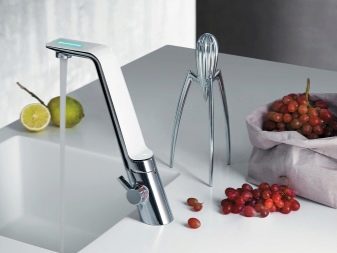
With separate taps
This version of the tap was invented a long time ago and is probably familiar to everyone. The design in this case is extremely simple - the controls are two separate valves for cold and hot water independently.
By adjusting the degree of moisture supply from each pipe, you find a balance that determines the strength of the total pressure and the temperature of the water. Its useful to note several key advantages of a mixer with separate taps, which still do not allow the "old man" to retire.
- Simplicity. The mechanism does not imply anything complicated in its design, and the simpler the product, the fewer parts there are ready to break. Even in the event of a breakdown, such a faucet can be repaired by any skilled man, not necessarily a plumber, and this is very practical.
- Cheapness. Again, the lack of an impressive set of parts makes the standard two-valve mixer an inexpensive product that anyone can afford. Those who want to save money without losing quality choose this option.
- Relative reliability... Periodically, even such a mixer requires maintenance, but in general, the new model does not fail for several years. In addition, the repair, as already mentioned, is quite simple and does not take much time.
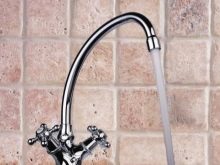

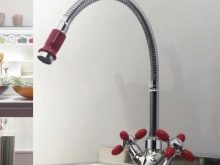
There are relatively few disadvantages, but to someone they may seem significant, namely:
- the water temperature will have to be adjusted anew each time, since it directly depends on the degree of openness of each of the valves;
- in a kitchen, this often has to be done with dirty hands, which is why the valve handles get very dirty and require additional care, for this reason, in recent years, two-valve taps have gradually disappeared from domestic kitchens, even if they remain popular in the same bathroom.
Single-lever
Two or three decades ago, single-lever mixers first burst into domestic life, which immediately turned the notion of a modest post-Soviet person about how long it takes to adjust the water temperature.
This type of crane is also familiar to everyone - control in this case is carried out using a single lever that rotates in two planes: lifting up and lowering down regulate the pressure force, while turning left and right sets the temperature of the water in one movement, adjusting the proportions of liquid from the cold and hot pipes. It is worth noting that single-lever mixers only appear the same from the outside, but in fact, their internal design may be different.
According to this criterion, they are divided into two main types.
- Ball valve It is based on a polished metal ball with three holes (two inlet and one outlet). Changing its position allows you to uniformly regulate the temperature and pressure. Such a mechanism is very simple, but the sealing gasket, which is in contact with the ball on most of the surface, somewhat interferes with the smoothness of the adjustment.
- Ceramic mixer regulates the parameters of the outgoing jet thanks to carefully polished sintered plates, which ideally fit snugly together. Such a design is good in that it provides the maximum smoothness of the lever rotation, but repairs can be difficult - there are several types of replaceable cartridge plates, and some manufacturers are completely guided by non-standard parts that are difficult to replace.
In addition, any dirt trapped between the two plates breaks the tightness of the mixer, so it is highly advisable to install an additional filter in front of it.
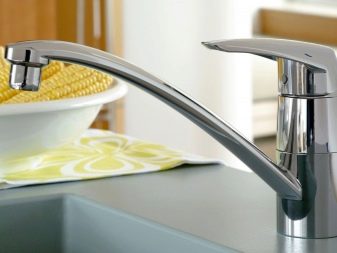
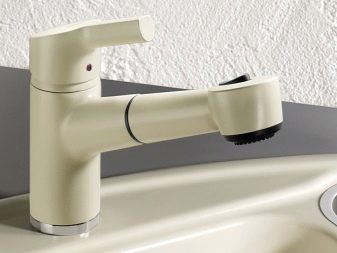
In recent years, such a mixer has been considered almost the best choice for the kitchen, and the reasons for this are obvious.
- Stable water temperature. Cold and hot water in our houses flows separately only because we cannot organize their joint supply in any way. However, in most cases, a person does not need either one or the other in its pure form - preference is given to a certain average temperature at which the water can be considered warm. The old two-valve crane had to be re-adjusted every time, but there would not be such a problem: if you set the lever to the correct position once, from now on you will only raise and lower it.
- Independent regulation of temperature and pressure. For two-valve taps, a change in one of these two parameters usually provokes at the same time a change in the second, or you have to turn the valves for a long time until a new ideal proportion is found. A single-lever mixer, from which an increase or decrease in head is required, simultaneously increases or decreases the flow of liquid from both connected pipes. Similarly, if it is necessary to change the temperature - by increasing the dosage of water from one pipe, it automatically reduces its amount from the other, but the total amount of the poured liquid does not change in any way.
- You can turn on the water with one movement of your hand. In a kitchen, this is very convenient, because dirty hands can often stain the valves by adding tasks for the next cleaning. The lever can be opened and closed with any part of the hand or even some foreign object, so that it stays clean for a long time.
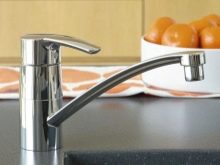
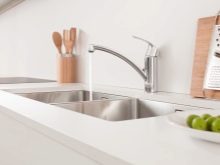
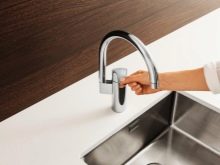
The following disadvantages are worth noting:
- a single-lever mixer is slightly more expensive than its two-valve counterpart, especially if you want to purchase a quality product;
- it is better not to save on the purchase, since self-repair in this case turns out to be a more difficult task - at least you should have parts for replacement, and with standardization, everything is much more complicated here;
- all the advantages associated with temperature stability and ease of regulation are relevant only as long as the pressure in the pipes is stable and symmetrical, and the temperature of the water supplied by them does not change depending on any external factors.
Thermostats
The thermostatic mixer can be safely considered one of the newest design options, even by now it has not become widespread. This is a kind of model that not every person had the opportunity to experience. In such a tap, the temperature and water pressure are regulated by different handles - in front of the jet force regulator is the thermostat knob itself.
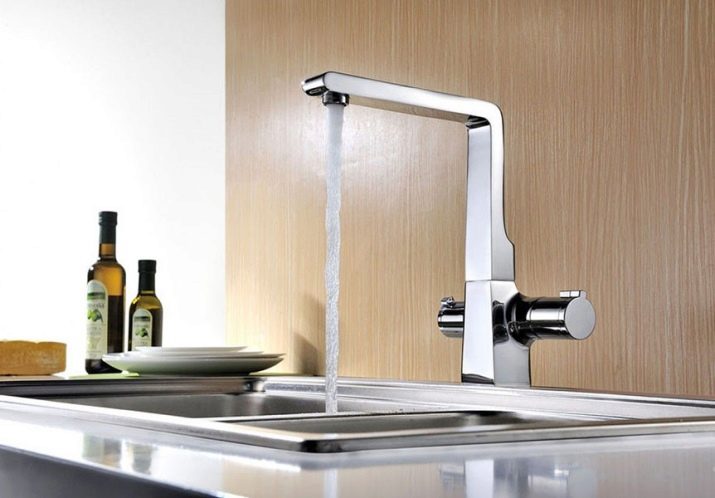
The device of the latter resembles a wax thermostat for a car engine: the mechanism is a sealed capsule, inside which is a substance. It melts and noticeably changes its volume depending on the temperature of the supplied water. Together with it, the capsule itself also expands and contracts, and already it regulates the ratio of cold and hot water so that it corresponds to the value you have selected with the handle.
The handle itself only affects the pressure inside the capsule, which affects the melting point of the wax inside.
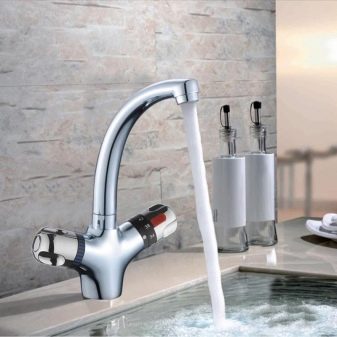

This means that you become completely independent from fluctuations in the temperature of the liquid in the pipes - your unit itself will each time find such a proportion of moisture so that the temperature will satisfy you.
The key advantage of such a valve is that it “does not trust” the stability of temperature and pressure, as in the case of a single-lever mechanism, and adjusts these parameters every time. At the same time, if cold water is turned off, you will never get scalded - the structure simply will not let the boiling water through, instantly blocking it. The “smart” device will not shut off the water if it “notices” that instead of hot water is supplied, and cold, even if not hot, is never blocked by the mixer.
It is clear that the cost of such an engineering miracle is quite high, and repairs are a difficult task that is associated with significant expenses.
note that the thermostatic mixer, unlike its more primitive counterparts, does not allow "confusion" of inputs... For everything to work correctly, hot and cold water must enter the mixer exactly from that side, as indicated in the instructions. For this reason, before buying, you should clearly find out which of the pipes goes to the mixer on the left and which on the right.
All leading manufacturers understand that the wiring can be different and they produce their popular models in two versions, so the consumer just needs to not be mistaken.
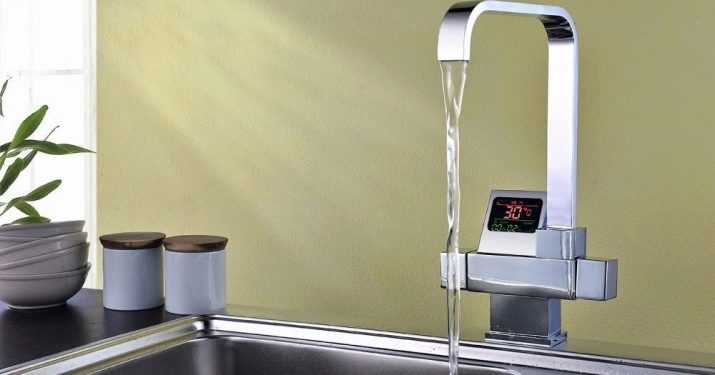
Electronic
Electronics have gained immense importance in the control of a wide variety of appliances and technologies in recent years, so it should come as no surprise that today even a kitchen faucet may require an electrical connection. Such an electrical appliance, depending on the model, may have many of the most unexpected featuresthat you might find useful in the kitchen.
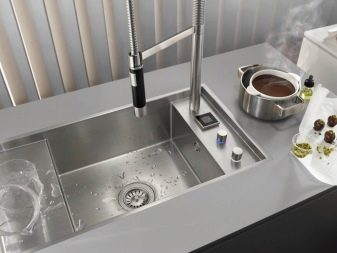
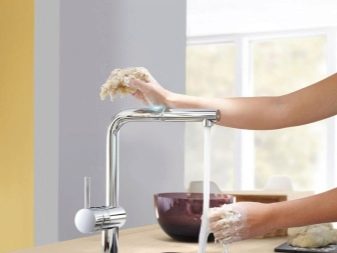
They should be considered more closely.
- Non-contact switching on and off... So far, such technology has not even been acquired in all public places where such a principle of operation is critically important, but for those owners who value maximum comfort, this is not a reason to abandon the novelty. Optical or any other sensor reacts when you get close to the sink and put something under the tap, and automatically turns on the water. The sensor unit with a motion sensor allows you not to get the control handle dirty (it just doesn’t exist), and also makes it possible to turn on the water even if both of your hands are busy. Among other things, it is impossible to forget to turn off such a mixer, it does not waste water - as soon as the equipment “understands” that there is nothing in its area of action, it automatically turns off the water supply.
- Debugging temperature. If the water supply in the house is not able to supply water at a stable temperature, then a heated mixer will be very relevant. He will not make boiling water out of cold water, but in the kitchen you will hardly need one anyway, but with a rather powerful device, you can not bring hot water into the kitchen at all. Among other things, the faucet always heats the water up to the specific temperature you set, and although it may take a few seconds, you could spend a lot more time adjusting the faucets every day.
- The ability to memorize several programs. The electronic device of some models does not shy away from simple programming. Unlike a single-lever tap, which can "remember" the proportions of water in a single setting, modern technology provides a much wider variety of actions. The device can be set both the temperature and the pressure - it will figure out how to provide the required parameters under the conditions of each separate moment. In addition, to solve different kitchen tasks, different temperatures and different pressure may be required - the unit will remember several presets at once, allowing with a slight movement of the hand to dramatically change all settings to those that are relevant now.
- Decorativeness. This feature is inherent only in the most expensive models, and it is unlikely to find application in the kitchen - such delights are more appropriate for a bath or shower. Therefore, we will only briefly mention that the electronic unit is able to illuminate the jet in different colors, focusing on the current water temperature, and also turn on music in parallel with the opening of the tap.



It would seem that such advanced technologies should no longer have drawbacks, but they are, and we are talking not only about the high price, which, of course, will seem excessive for most average consumers. These include the following:
- overestimated design complexity leads to the fact that one or the other node will fail, so the cost of money and nerves for maintenance can be very disappointing;
- not every plumber will undertake to repair your overseas miracle, shining in the process of work with all the colors of the rainbow;
- the operation of the mechanism depends on the supply of electrical energy, and when the latter is turned off, you will encounter an unusual situation when at the same time there is no water.
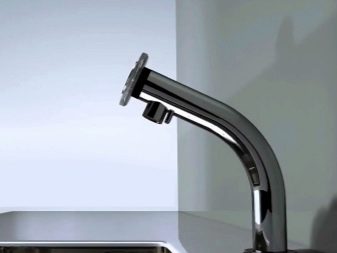
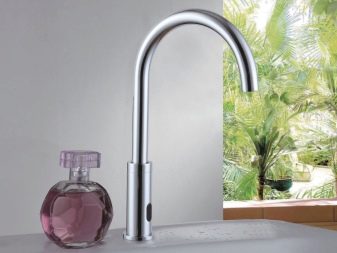
With double spout
Such a device is most often another type of single-lever mixer with all the advantages and disadvantages of this design. The fundamental difference is that here a separate spout for the filter is provided - it turns out that filtered water does not mix with tap water and vice versa.
Such a solution is very important for practical owners who have heard a lot about the dangers of untreated tap water, but at the same time understand that there is no point in filtering it for any needs. For example, for drinking, cooking and washing foodstuffs, maximum purity of water is desirable, and dishwashing is possible with plain tap water. This approach is appropriate, since any filter becomes more dirty the more dirty water you pass through it. Cleaning and replacement costs money, in addition, it costs time and effort, which is inconvenient, so many owners would like to make the procedure as rare as possible.
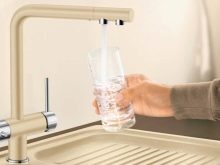

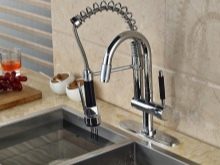
The smartest way to make this a reality is to have water that does not require filtration bypass the filter, and that is why the dual-spout faucets were invented for this purpose.
Shapes and sizes
One of the most important factors in choosing a mixer is the parameters of its spout, since in many respects they determine the convenience of its use. You should choose not only for external attractiveness - you should objectively evaluate the practicality of the model in a kitchen.
A swivel kitchen spout is a mustas it at least helps to clean up the sink. When it is loaded with dishes, you should be able to redirect the jet so that the splashing water from the dishes does not spread throughout the room.
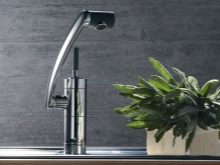
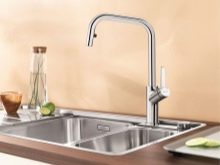
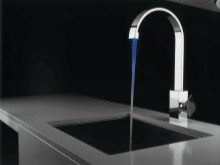
At the same time, some kitchens are equipped with two or more washing departments at once, in this case the question of the possibility of turning the spout does not arise.
When choosing the height of the spout, you should focus on the same convenience: all dirty dishes should be placed under the tap, but water will inevitably spray out when dropped from a great height.
There is a classification according to which spouts are low (up to 190 mm), medium (190-240 mm) and high (over 240 mm). An average indicator, taking into account the above criteria, seems to be the most suitable, but if the mixer is purchased separately from the sink, the depth of the latter should also be taken into account. The length of the spout should also be determined according to your own needs. Equally impractical are taps with both short and long spouts, since in both cases the predominant part of the sink is inaccessible to the direct jet.
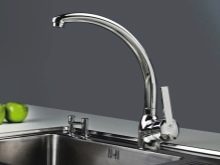

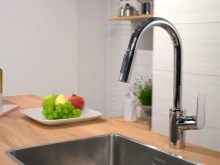
Ideally, it should be possible to direct the water flow around the middle of the sink.
Experts see the dilemma also in whether to choose a solid combination of the mixer and its spout or a prefabricated model. An integral frame is much more durable, leaks are unlikely to be terrible for him, and it is also convenient in terms of maintenance, but repairs, if necessary, will be complicated.
The spout can be of any shape - square, elbow or curved. This is purely a matter of aesthetics, unless you have chosen a folding or articulated option that can bend like a hose - then its stream can be directed to absolutely any point in the sink. This solution should be considered very practical.
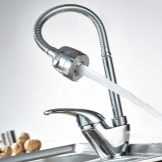
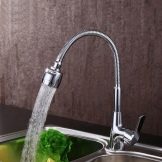
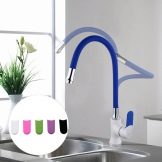
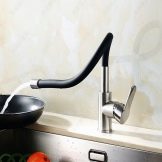
If the manufacturer has no doubts about the build quality, then such a purchase is worth the money spent on it.
Materials (edit)
The durability of the kitchen sink faucet and the ease of maintaining it largely depend on what the unit is made of. Contrary to popular belief, it's not just the case that is worth evaluating - any detail of the unit matters, and they are made from different materials... Different types of metals are almost always used as materials for the body.
Zinc, white in section, usually weighs relatively little and is characterized by increased fragility, therefore this is the cheapest option, which is not considered a standard of quality. More widespread enclosures stainless steel and brass - at relatively low prices, these metals provide good strength and durability, and they look good.
Rare materials include copper and bronze, but the reason for their rarity is the opposite of that of zinc - these metals look noble, but are much more expensive, so not everyone can afford it.
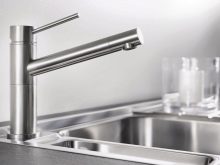
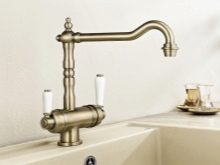
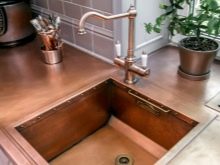
The best combination is considered to be a metal body and a ceramic-based filling.but today's industry can offer a mixer made of just about anything. If you wish, you can find a plastic, silicone, ceramic or granite faucet that will look more original than 99% of its counterparts, but any of these materials have less impact resistance, so you need to be careful with them.
Whichever metal you choose (and this is the most likely choice), it is desirable that it be protected by something outside. The chromium coating is considered one of the most reliable in terms of long-term service, but this is not always preferred, since the consumer does not have the opportunity to choose the color of the product, which also tends to become very quickly covered with visible stains of dirt.
In an aesthetic sense, enamel is much better., which gives a choice of shades, but it is inferior in strength and may lose its original shade, and in the worst case, even flake off. The optimal solution may be faucet design in bronze, since there is not particularly noticeable pollution, and maintenance is extremely simple.
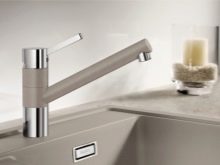
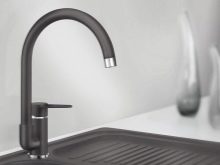
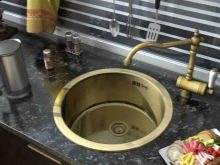
Important! Experts usually point out the fact that a quality mixer must be heavy. Consumers are accustomed to choosing the lightest product in most cases, but this is just the exception to the general rule.
Style solutions
If you are trying to give any outstanding stylistic features to the design of your own kitchen, you should be guided by the fact that the mixer must comply with the general principles, otherwise it will spoil the overall impression of the room.
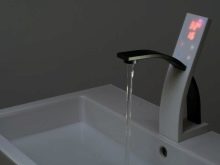
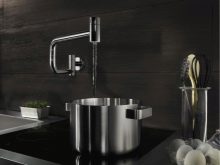
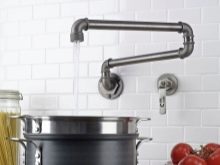
For most owners, it is a mystery how to fit a crane into one style or another, therefore, here are some useful tips.
- Classic and retro style. Let's be objective - mass water supply and large-scale industrial production of taps began not so long ago, since then, say, seventy years have passed. Before that, faucets were a relative curiosity - they, like the plumbing, were in the houses only of relatively wealthy citizens, and they often ordered the manufacture of such a unit individually or bought it in a factory version, but still without the current standardization. This allows us to draw two conclusions: that a classic crane should not have a banal and too standard form, and that its rich look will play into the hands of the designer.
Adherents of the classics usually do not skimp on design, so you try to do without cheap fakes. Finally, remember that you are imitating the past - there is no need for trendy modern technology.
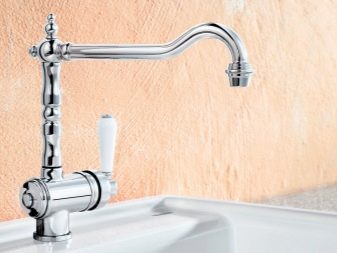
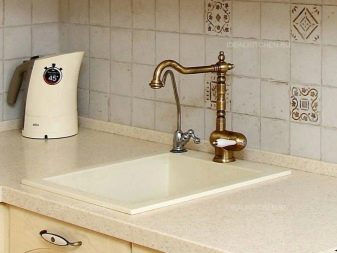
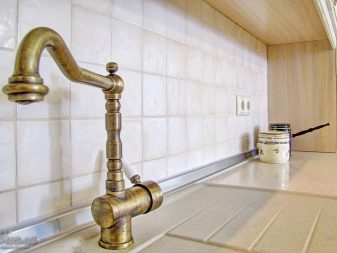

- Modern... Modernity in design is usually associated with the rigor of design - most of the details will be excluded if they play a purely aesthetic role, but practicality is of great importance. A mixer can look simple, it doesn't have to be expensive when it can belong to a serial line, if only the interior looks holistic and uncommon. At the same time, original design solutions are not prohibited, but keep in mind that in the kitchen, a bright accent should be made not on the sink.
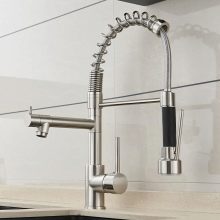
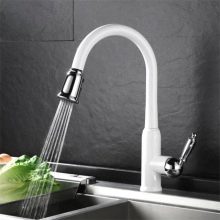
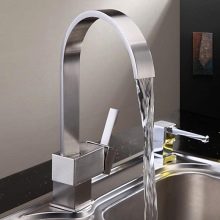
- Ethno and country. These are all names for the same style, which takes on different features depending on which country village you are trying to portray. Interestingly, the variety of design options has practically no effect on the recommendations for the crane - in almost all cases it should look unusual and rare, be it Provence, African or Japanese style.This requirement is due to the fact that traditional culture is usually opposed to modernity, which means that the mixer should look as if it has remained “from those times”.
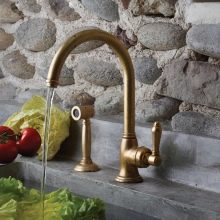
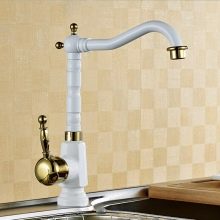
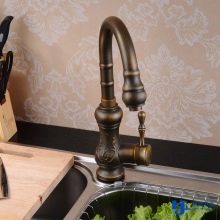
Manufacturers overview
We deliberately refuse to compile a full-fledged rating with the distribution of places, since we understand that each consumer can have their own evaluation criteria, and each manufacturer has both more and less successful models. Nevertheless, there are several firms that deserve only flattering comments about their products.
Any plumber will tell you that choosing taps from these brands is this is a solid investment in the future, so it is worth getting to know them before going to the store.
- Grohe, Hansa and Hansgrohe. Three German brands, necessarily included in any top, can be combined in one point, since the main thing for any German company is the highest quality of the goods produced. These manufacturers simply do not know what marriage is, but they have a subtle sense of style. Sometimes they are accused of not paying enough attention to stylish retro models, but there is nothing more to complain about - even a rather high price is fully justified.
- Geberit. The Swiss are the same Germans with inveterate scrupulousness and increased attention to the smallest details. This brand has become famous primarily thanks to technological faucets equipped with infrared sensors and able to save water.
- Oras. In Finland they also know how to make mixers and the local craftsmen do it quite well. Finns have been present on the domestic market for a long time and are well known to the consumer due to the reliability and durability of their products, the confidence in which allows the manufacturer to give impressive guarantees. This brand is criticized only for the rather high prices for modern sensory products - what can you do, in Scandinavia the standard of living is higher.
- Vidima. Our consumer is already accustomed to the fact that Europe and North America make high quality, but expensive, and China - cheap, but short-lived. Do not think that a certain golden mean is an unattainable ideal: the Bulgarian company, located in the European Union, produces products that meet the best expectations and highest standards. Since the local labor force is quite cheap, our compatriots can also buy such a crane.
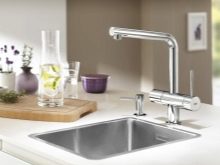
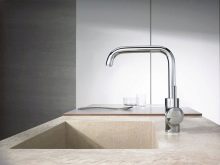
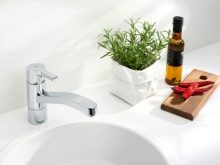
Other popular brands include Spanish Roca, French Jacob Delafon, Italian Cezares and Czech Ravak.
Selection Tips
So that the purchased plumbing does not disappoint, there are a few things worth paying attention to.
- When choosing a mixer in terms of height, focus on the depth of the sink. To accommodate a sufficient amount of dishes and avoid splashes, the height of the spout is important in relation to the bottom of the sink, and not to its base, so when purchasing a sink and a faucet separately, evaluate their compatibility from this point of view.
- If you are not using tap hot water, but you use a water heater, buying an electronic tap with heated water seems unnecessary. In any case, both devices depend on electricity, so in most cases the functions will simply be duplicated, and you will overpay for nothing.
- Mixer with lever on spout It may seem strange at first glance, but if your sink is large, it may be uncomfortable for a short person to reach for the lever, which is traditionally located at the base of the spout. In this case, it makes sense to meet the owner halfway and choose a model with control in the free access zone.
- When installing a sink under the window tall spouts are usually not used. It is assumed that you have a window so that while doing kitchen chores you have the opportunity to admire the opening view, and the protruding faucet will interfere with this.
- A professional plumber will never purchase a product from hands or in dubious stores. There it is usually unrealistic to buy a high-quality mixer from a good manufacturer, and even with a guarantee, but there is every chance of spending money on a low-quality fake.
- Without being a specialist in the mixer world, take an interest in the leading brands of such products - most likely, you will hear their names for the first time. Do not be lazy to remember exactly how these names are spelled, because the Chinese do not sleep and love to pamper our compatriots with surprisingly cheap branded faucets with a random one-letter typo.
- Make sure that the package is complete. The same flowing flexible hoses supplied in the kit are often too short to install, and this can be an unpleasant surprise that requires a second trip to the store.
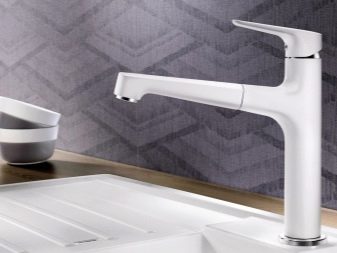
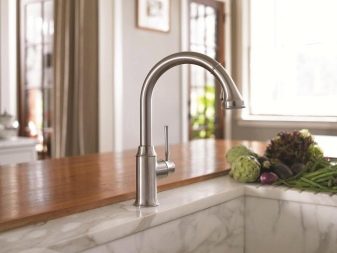

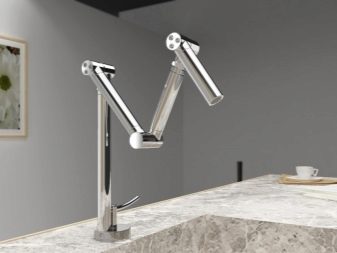
Care
A quality product will last for many years, but it is important that it does not lose its original appearance, otherwise the need for replacement may arise unexpectedly early. Typically, most potential stubborn dirt can be removed relatively easily if the problem is dealt with as soon as it occurs - simply wipe down the faucet. soapy water or vinegar, lemon juice or vodka.
The listed liquids are applied not to the stain itself, but first to the sponge, after achieving the required result, you need to rinse the body with warm water and carefully wipe it dry with a soft cloth. Experts advise to use only filtered water - thanks to this you ensure that new stains are not planted on the product during the washing process.
In addition, the maintenance of the tap includes periodic replacement of gaskets and cleaning of the aerator - ignoring these requirements, you will notice a decrease in the productivity and quality of the mixer. In the case of simple structures in the form of a two-valve tap, you can usually cope with the tasks on your own, without resorting to calling a plumber - disassembly and assembly turn out to be tasks on the shoulder for the average man who is not afraid to roll up his sleeves.

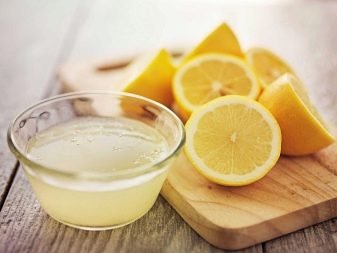
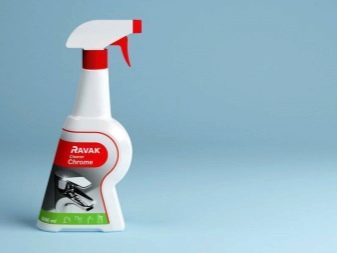
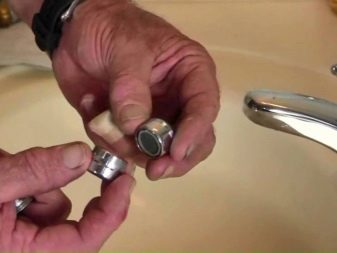
How to choose a faucet for your kitchen, see the video below.








